Paris takes center stage in Roaring 20s at Tribeca. Like a relay race with characters handing off the baton, it is shot seemingly in one take along rue de Rivoli, the Louvre Pyramid, quays of the Seine, Pont-Neuf bridge, Chatelet and République Metro stations, Saint-Martin Canal, Belleville and finally Parc des Buttes-Chaumont. The character hand-offs range from two women who walk along the Seine carrying a black statue and talk about the copyrighted color black by artist Anish Kapoor that only he can use; to a wandering bride who abandoned her wedding; teenagers who steal makeup; a man fetching a friend’s sister at the train station; and a comedian who wants to get out of the business. The action takes place during COVID (the title refers to the year 2020) evidenced by masked donned when entering the Metro. Eventually, all 24 actors comes together in song.
Gallant Indies at Sheffield shows a different reading of Paris where the city symbolizes the world’s diversity. Hailing from all over the globe, dancers living in Paris were brought together by the Paris Opera for a production of the 18th century opera Les Indes galantes (The Gallant Indies, 1735), an opera about ethnic groups and love in four corners of the earth by Jean-Philippe Rameau (1683-1764). Written during the Enlightenment, Rameau swapped cliches describing Turks, Incas, and Persians from bloodthirsty to noble savages (think Jean-Jacques Rousseau) but still maintaining that period’s Western view of the “native” uncontaminated by civilization, a condescension heralding colonialism. The contemporary production’s embrace of “urban culture” presents dance styles from around the world: krump, locking, vogueing, popping, jumpstyle, and hip-hop. Exuberant costumes of fishnet bodysuits depicting skeletons and tattoos, sexy dresses for women dancing in cages, and street garb enliven the production. The director Clément Cogitore asks, does it make sense to put these dances against Rameeau’s work and answers “I’ve never seen a Black person at the opera.” The choreographer Bintou Dembélé says that body holds a thousand years of history.
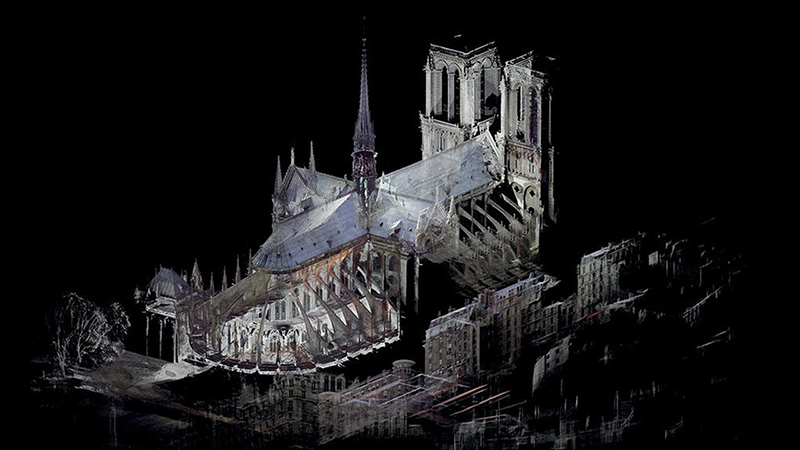
Sunny Side of the Doc declares itself the international marketplace for documentary and narrative experiences, thus shows trailers for upcoming films often still in production. Staying in France, we saw Raising Notre Dame about reconstructing the Gothic cathedral in Paris after the 2019 fire which showcases the largest 3D model ever made. Fly-throughs of the building show the damage and splendor.

Also at Tribeca, we got two walkthroughs of New York City. In Italian Studies, Vanessa Kirby’s character walks through Manhattan, first in Chinatown, then W. 4th Street, and on to Chelsea and Penn Station. She is a writer who has amnesia, and wanders the streets trying to find her way home with adventures along the way. The Kids, a look back at Larry Clark’s film Kids (1995), portrays 1980s New York City — drugs, sex, HIV, homelessness, skateboarding — as teenagers develop a makeshift community.
Another New York story was at Tribeca Immersive, the section showcasing AR and VR. Lovebirds of the Twin Towers tells the true story of Carmen and Arturo Griffith, two elevator operators who worked at the World Trade Center for more than 20 years who were saved by co-workers on 9/11. Through the use of VR, Carmen’s recollections bring back a time when the Twin Towers dominated the downtown skyline and the day they were destroyed.
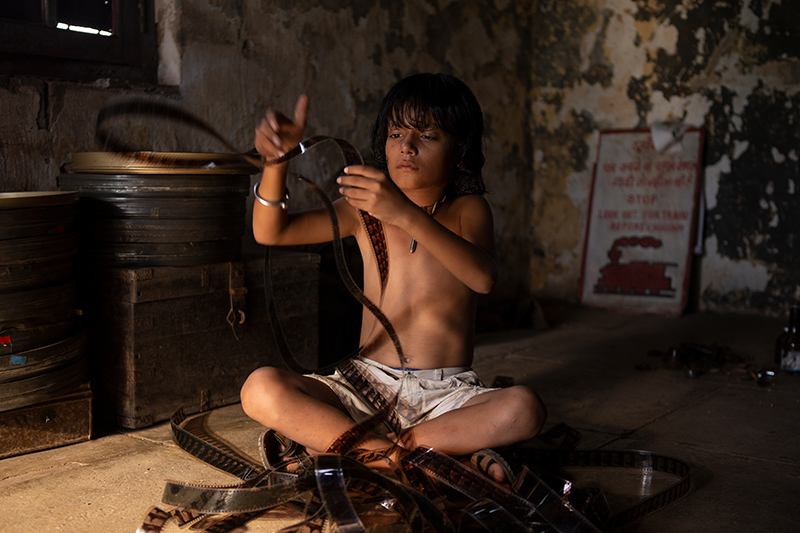
Tribeca treated us to The Last Film Show, the India equivalent of Cinema Paradiso (1988). A child enamored of film, regularly sneaks in to the screening booth in exchange for his mother’s delectable food. The screenings stop and the projectionist is out of a job when the cinema goes from celluloid to digital projection.
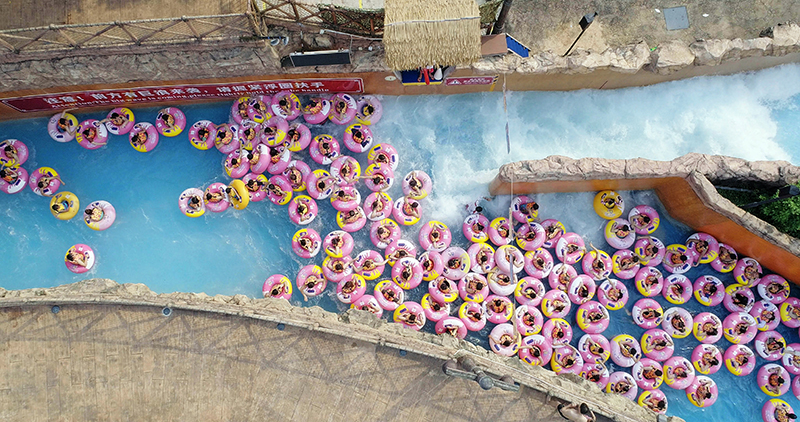
A batch of films focused on placemaking, the first cluster at Tribeca. Taking the top documentary prize is Ascension, “an exploration of contemporary China’s identity as it relates to its vision of consumerism, innovation, and social standing.” You’ve heard of the American dream — this is the Chinese dream. We start with factories: the jobs (strict rules like no phones, no criminal records, no tattoos); dorms (8 people to a room, no AC, no health tests); transport (giant screens at crosswalks, piles of bicycles); sustenance (vats of cooked food, animal parts); and endless repetitive work on vast assembly lines (metal recycling, plastic containers, denim clothes, MAGA hats, sex dolls).
At Paradise Ocean Park, the chairman of JALA, a cosmetics company, addresses a ballroom full of employees saying “Along with growth comes a social phenomenon, which is wealth redistribution. And wealth only goes to those who deserve it.…If your wealth doesn’t match your intelligence, society will have hundreds of ways to take your wealth away.” The hotel sports towels folded into swans dusted with rose petals, gigantic fish tanks, cars displayed in the lobby, surveillance cameras and a clear acrylic swimming pool.
Another strata of work is exemplified by the Star Boss Entrepreneurial Academy where classes train aspirants to be a “star boss” and get fans for their personal brand “no matter how ordinary you are.” The results are people are hawking products such as personal grooming like a hair stick (like a glue stick for hair), how to tie a scarf and makeup tutorials. They are told “Every Chinese woman is a pretty Chinese business card….Let’s bring the pride of China’s 5,000 year history to show the world the prettiest smiles.”
“In this age of internet, either you influence me or I influence you. Either you’re overwhelmed by my ads, or I’m overwhelmed by yours.”
A class teaches “Ways of Business Etiquette” answering such questions as “At work, how many teeth shall we show when smiling? Eight…If you want to hug someone, you should get 5-7 steps away.”
There are classes on how to be a butler. “Has anyone seen Downton Abbey?” Warning: “You can’t show a sour face to your employer… No matter how he humiliates you when facing him…You can curse him behind his back.”
The film’s title comes from the poem “Ascension” written in 1913 by director Jessica Kingdon’s great grandfather Zheng Ze: “I ascend and look far into my heart only to find that everywhere is already razed”.
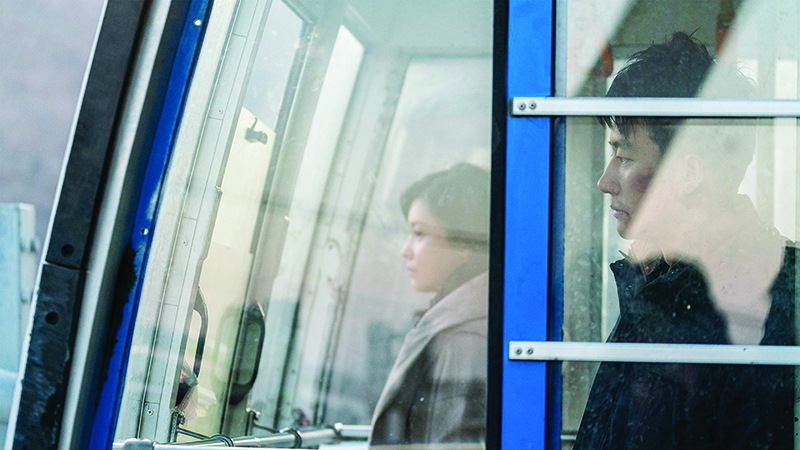
Also set in China is Wu Hai. Set in the Inner Mongolian city of Wuhai located between the Gobi and Ordos deserts, a failing dinosaur theme park spurs a financial crisis. Money problems extend to the Desert Moon Resort, an arts park in the desert with installation art, gleaming white tents and a live orchestra. They try to build make-believe worlds, all of which fail.
Reflection: A Walk with Water chronicles a 3-week walking pilgrimage along the several hundred mile-long Los Angeles Aqueduct originally constructed at the beginning of the 20th century under engineer William Mulholland (think Chinatown, 1974) to provide the city with much-needed water. The source is from the Owen’s Valley that is now a desert, farmland sacrificed to water supply. Experts show an alternative by utilizing rain water, which is currently syphoned off into sewers and not utilized, coupled with planting trees that function as a sponge for water-replenishing acquirers, a system introduced in Melbourne, Australia, where 3,000 volunteers planted 7 miles of trees in 3 hours, the world’s largest “living monument” project, dedicated to MLK and reshaping society with water in mind.
With/In Vol. 1 & Vol. 2 is, unexpectedly, a COVID anthology travelogue or "a cinematic time capsule” made with simple equipment like iPhones. Most of the 13 vignettes feature real-life actor households or friends in their actual homes, and without outside crews. Says EP Celine Rattray, “families were their own directors, DPs, sound, lighting, costume designers, production designers, script supervisors, first AD — every role was done by the families.” The families included married couples Rebecca Hall & Morgan Spector, Deborah Winger & Arliss Howard, Chris Cooper & Marianne Leone, Alessandro Nivola & Emily Mortimer and their kids (their son directed), Bill Camp & Elizabeth Marvel and their son, Julianne Nicholson & Jonathan Cake and their kids, and mother/daughter Trudie Styler & Mickey Sumner. The stories revolve around circumstances endured during the pandemic in amusing and serious ways, some in cramped city apartments, others in beautiful country houses and everything in between. Total voyeurism.
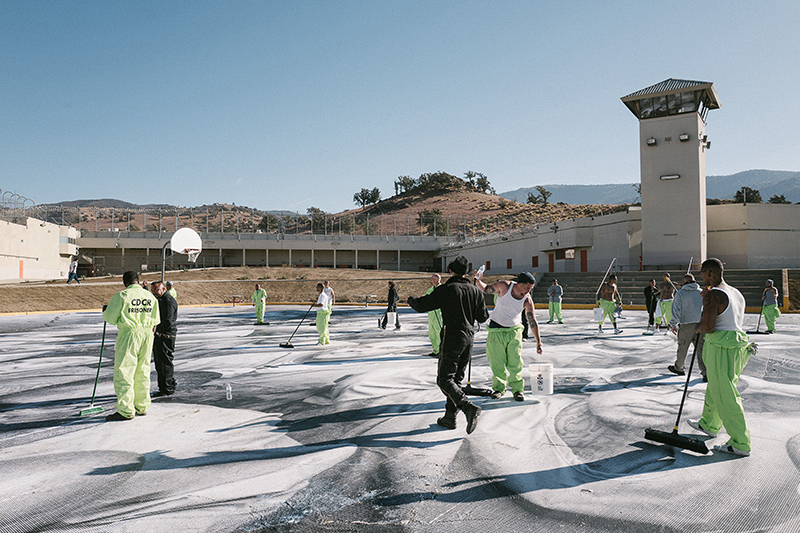
Paper & Glue begins with JR, French photograffeur (photographer + graffiti artist), enlisting inmates at California Correctional Institution (CCI), a Supermax state prison near Tehachapi to participate in a site-specific art program. He tells them about a project on the U.S./Mexico border where he posted a large B&W photos of a boy on the Mexican side lifted up high appearing to peek over the fence. People visited the border, taking selfies with the toddler’s image. On the last day, a 36’-long picnic table with a tablecloth emblazoned with JR’s photo of the eyes of Mayra, a “Dreamer,” straddled both sides of the border, looking from above like a continuous surface. Food was passed through the fence, photos were snapped, and a U.S. border guard joined in.
Back at Tehachapi, the inmates were persuaded. An aerial photograph of 48 inmates looking skyward taken from a drone (the prisoners had never seen a drone before) is pasted onto the prison yard by the inmates themselves. Here we see the prisoners in green jumpsuits walking across the expanse of the B&W photomural beneath their feet.
These examples of JR’s moving, politically engaged work is the backdrop for telling his artistic journey starting in 2001, tagging graffiti in Paris housing projects in the 11th arrondissement — near the public housing where he grew up, a child of immigrants. He added photos to his graffiti, spray painting frames around them, and he always documented his process photographically.
Two years later, at Les Bosquets Houses in Montfermeil, he started a project that laid the groundwork for his current practice of large-scale B&W photos affixed to public sites, with Ladj Ly, who went on to direct the award-winning film Les Misérables (2019), also set here, the poorest neighborhood in France with neglected public housing blocks, non-working elevators, broken lights, and crime everywhere. When he started, locals asked JR to take their photo, and he decided to flypaper their buildings with their images — which was completely illegal — a series he called Portraits of a Generation. One featured a youth with a gun pointed directly at the camera, while a group of young men stand stoically behind. JR only had a 28mm lens, so had to be very close to his subjects and their faces are huge. JR posted their names, ages and building numbers underneath, so these scary thugs became real people whose doorbells you could ring.
Although invitations went out to view the works, few came as the neighborhood was considered too risky. However the story was covered by media and online so foreign tourists blithely came. Many photos were hosed down and removed, but JR’s career was launched.
JR recently revisited Les Bosquet with an updated project at the same time he was commissioned to do an installation at the Louvre Pyramid.
Brazil is another fertile venue where he gained the trust of drug dealers and local residents of the Morro da Providencia favela in Rio de Janero. His project on women as the backbone of the community has grown into a worldwide project, Women are Heroes. Here, he pasted eyes on the facades of shanties. He then bought an empty house and turned it into Casa Amarela (“yellow”) an education, art and social support center.
Sheffield screened RIP SENI, a story about graffiti that appeared on June 24, 2020 on an outdoor public artwork called “Some Questions about Us” by Mark Titchner installed along the perimeter of Bethlem Royal Hospital, a psychiatric facility in SE London. Commissioned by Bethlem Gallery’s Mental Health and Justice Project, the artwork consisted of 8 mirrored placards asking questions related to mental capacity such as “Do You Understand the Decisions That You are Making?,” “Is Your Life Governed by Your Own Principals?,” “Do You Act Without Controlling Influences?,” “Are You Free to Determine Your Own Actions?,” and “Is A Decision Made with Support Still a Decision?”
Seni Lewis was a 23-year-old Black man who died at the hands of 11 police officers while at the hospital, who were found guilty of excessive force but have not been prosecuted or disciplined despite the verdict. To families of victims, the graffiti brought the artwork to life, and made it more powerful. The graffitied placards were brought inside to the gallery where they are on permanent display.
Tribeca Immersive, the showcase for virtual projects, showed Jailbirds, with a pair of inmates locked in a bleak and cheerless prison. “The whole subject of this story is freedom of movement, about space and claustrophobia,” said director Thomas Villepoux. “Being able to render and explore that idea in volumetric space was interesting to me, to gently push users outside their comfort zones.
Life in Pieces: The Diary and Letters of Stanley Hayami is set in a Japanese internment camp, a California house, and the European front during WWII. Los Angeles native Stanley Hayami is an American teenager attending Mark Keppel High School in Alhambra, writing in his journal about school and his dreams of becoming an artist. But this is 1942, and his Japanese-American family is imprisoned at Heart Mountain concentration camp in Wyoming.
Marco & Polo Go Round in a gravity-free world. A couple. Marco and Polo, literally rise in this kitchen-sink drama that quite literally turns itself upside down. As the couple’s argument escalates, gravity reverses, sending appliances, furniture, and eventually the couple themselves off the ground and into the sky.
POV: Points of View enlists viewers to follow the case of Cassius, a Black USC student, arrested on trump-up charges, who is eligible for early release under a new drone-surveillance program equipped with artificial intelligence and weapons to record his every move. We are charged with evaluating how machine-driven data and human-driven biases (especially on the part of police) impact the outcomes.
Procession by artist Dustin Yellin, is an AR artwork set in a utopian world where climate change wreaks havoc as we watch — and are implicated.
At Sunny Side of the Docs we got sneak previews of What Killed the Roman Empire? citing climate change and pandemics as well as Barbarian invasions; Wild Travels: America’s Oddest Museums, which highlights quirky repositories for mustard, pinballs, dust, action figures and portraits made from bugs located in hotel lobbies, homemade castles and abandoned barns; Florian’s Witnesses about Kyiv-based architect Florian Yuriev, whose masterpiece UFO building, the Ukraine Institute of Scientific, Technical and Economic Information and State Scientific and Technical Library (1971) sporting a futuristic flying saucer dome (a concert hall) and the city’s first glass skyscraper and a key example of Soviet Modernism is under threat by developer Vagif Aliyev who plans to tear down the building to make a shopping mall, and at age 90, this architect, artist, violin maker, musician, theorist and poet strikes back to save his masterpiece; Inside the Balmoral: Scotland’s Finest Hotel — An Extraordinary Year chronicles a year of COVID at “the grand old lady of Princess Street,” a 5-star Victorian Scottish baronial-style Rocco Forte Hotel that has welcomed royals, celebrities (Elizabeth Taylor, Sofia Loren) and lives up to the name’s meaning, “majestic dwelling” in Gaelic; The Improbable Journey of Berta Benz, the animated telling of the 39-year old wife of Karl Benz (Mercedes Benz) who took her husband’s horseless carriage on a 60-mile road trip when it was illegal to do so, to demonstrate the usability of the first gasoline-powered vehicle, using innovative solutions (hatpin to clear a clogged fuel line, garter to insulate a short-circuited wire) en route; WWII by Drone, a series following military experts who use drones to find long-lost battlefield remains for clues to warfare at such sites as the Battle of the Bulge; Backlight Shorts, 10-minute films on sustainability and technology, focusing on such subjects as creative things to do with space junk (artificial shooting stars to replace fireworks) and future fashion (targeting the biggest polluter after oil using recycled materials); and Untitled Digital Privacy Project (also at Tribeca) where a human rights activist is prosecuted as a terrorist for refusing to hand over the passwords to his electronic devices during a border stop.
Also at Tribeca was Stockholm Syndrome directed by The Architects, an anonymous collective of “filmmakers, thinkers, and builders” who use that name for unknown reasons. More on point was Father of the Cyborgs on Dr. Phil Kennedy, a pioneer in brain-to-computer interfacing that helps people with “locked-in syndrome” like ALS (Stephen Hawking) to speak or move when then cannot. He notes that the ballpoint pen and typewriter were devised for people with disabilities, and similar breakthroughs will yield universal design for everyone. Kennedy made global headlines in the 1990s for implanting wire electrodes in the brain of a paralyzed man and then teaching him to control a computer with his mind, and was compared to Alexander Graham Bell in The Washington Post. He then decided to have an electrode planted in his own brain in Belize, a site of medical tourism, to further his research. Is he brilliant or crazy? Is there a future where technology and human brains are combined?
Another rich vein were films about the arts. Tribeca hosted many including The Lost Leonardo about the controversial Salvator Mundi painting that may or may not be by da Vinci, getting under the skin of art attribution, freeport tax-free storage facilities and politics of the art world. The “Male Mona Lisa” was sold to a Russian oligarch, sold at Christie’s for a record $450 million, and sold to Saudi prince Mohammad bin Salman. It has not been seen in public since.
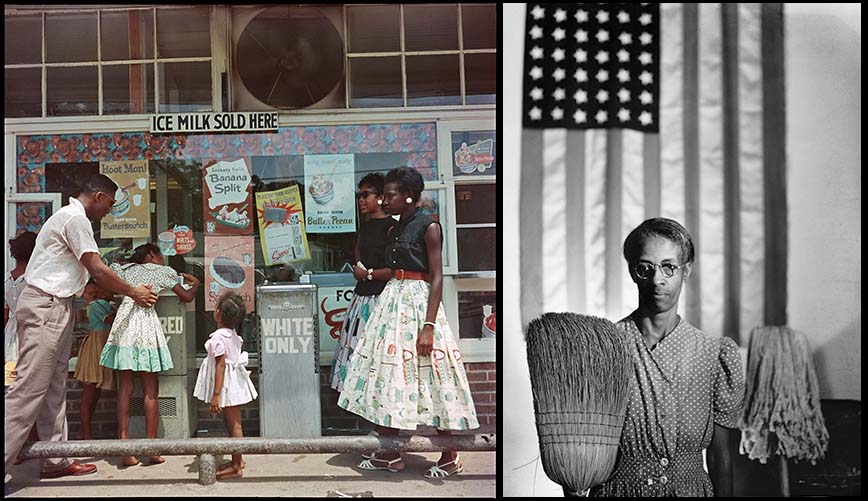
A Choice of Weapons: Inspired by Gordon Parks not only outlines the career of photographer and filmmaker Parks, the first Black staff photographer on Life Magazine who Ford Foundation President Darren Walker calls “a warrior for justice,” but current artists influenced by him including LaToya Ruby Frazier, Jamel Shabazz, Devin Allen, Ava duVernay and Spike Lee. The One and Only Dick Gregory shows the iconic Black comedian, active in the civil rights movement.
Sunny Side of the Doc showed The Sit-In: Harry Belafonte Hosts the Tonight Show the week when the actor/activist filled in for Johnny Carson and brought on Martin Luther King Jr., Lena Horne, Nipsey Russell, Bill Cosby, Bobby Kennedy and a host of others to discuss politics, current events, and the arts in the tumultuous year 1968, in the thick of the Civil Rights movement and the Vietnam War.
Sheffield offered Drawings of my BF, portraits by Wilfred Wood of Theo, the model who became his partner; No Straight Lines:The Rise of Queer Comics (also at Tribeca) which shows the evolution of how graphic arts have depicted issues of their day including sex, drugs, racism and AIDS, and morphed from underground comics to do-it-yourself zines to graphic novels; and many music titles: With Sonia Wieder-Atherton on the cellist; Son Chant on the same cellist’s ongoing collaborations with filmmaker Chantal Ackerman, who also made the first film (the title shortens each of their names, and the French “chant” translates to “song”); Blondie: Vivir en la Habana on Debbie Harry’s performance in Cuba; the female Cuban a cappella group Vocal Vidas performing in Los Angeles in Soy Cubana; and Lydia Lunch: The War Is Never Over, Beth B’s tribute to the uncompromising, confrontational musician and performance artist.
A slew of films on music were at Tribeca including Bernstein’s Wall on composer and conductor Leonard Bernstein, BITCHIN’: The Sound and Fury of Rick James; A-ha The Movie about the Norwegian rock band famous for the song “Take On Me,” and The Conductor about female conductor Marin Alsop who in addition to her role as Music Director of the Baltimore Symphony Orchestra took on a position as Principal Conductor at the São Paulo State Symphony Orchestra because she originally fell in love with the concert hall, the renovated Júlio Prestes Train Station.
All Films & Projects Mentioned
Sheffield
Blondie: Vivir en la Habana, directed by Rob Roth
Drawings of my BF, directed by James Cooper
Gallant Indies, directed by Philippe Béziat
Lydia Lunch: The War Is Never Over, directed by Beth B
No Straight Lines:The Rise of Queer Comics, directed by Vivian Kleiman
RIP SENI, directed by Daisy Ifama
The Son Chant, directed by Vivian Ostrovsky
Soy Cubana, directed by Jeremy Ungar, Ivaylo Getov
With Sonia Wieder-Atherton, directed by Chantal Akerman
Sunny Side of the Doc
Backlight Shorts, Dutch CORE
Florian’s Witnesses, directed by Oleksiy Radynski
The Improbable Journey of Berta Benz, directed by Deborah Hutchinson, Keith English
Inside the Balmoral: Scotland’s Finest Hotel — An Extraordinary Year, directed by Danny Fildes
Raising Notre Dame, directed by Vincent Amouroux
The Sit-In: Harry Belafonte Hosts the Tonight Show, directed by Yoruba Richen
Untitled Digital Privacy Project, directed by Kate Stonehill
What Killed the Roman Empire?, directed by Frédéric Wilner
Wild Travels: America’s Oddest Museums, directed by Harvey Moshman
WWII by Drone, Like a Shot Entertainment
Tribeca
A Choice of Weapons: Inspired by Gordon Parks, directed by John Maggio
A-ha The Movie, directed by Thomas Robsahm
Ascension, directed by Jessica Kingdon
Bernstein’s Wall, directed by Douglas Tirola
BITCHIN’: The Sound and Fury of Rick James, directed by Sacha Jenkins
The Conductor, directed Bernadette Wegenstein
Father of the Cyborgs, directed by David Burke
Italian Studies, directed by Adam Leon
The Kids, directed by Eddie Martin
The Last Film Show, directed by Pan Nalin
The Lost Leonardo, directed by Andreas Koefoed
No Straight Lines:The Rise of Queer Comics, directed by Vivian Kleiman
The One and Only Dick Gregory, directed by Andre Gaines
Paper & Glue, directed by JR Project
Reflection: A Walk with Water, directed by Emmett Brennan
Roaring 20s, directed by Elisabeth Vogler
Stockholm Syndrome, directed by The Architects
Untitled Digital Privacy Project, directed by Kate Stonehill
With/In Vol. 1 & Vol. 2, directed by Bart Freundlich, Sam Nivola, Morgan Spector, Maya Singer, Sanaa Lathan, Chris Cooper, Mickey Sumner, Rosie Perez, Arliss Howard, Griffin Dunne
Wu Hai, directed by Ziyang Zhou
Tribeca Immersive
Jailbirds, directed by Thomas Villepoux
Life in Pieces: The Diary and Letters of Stanley Hayami, directed by Nonny de la Peña
Lovebirds of the Twin Towers, directed by Ari Palitz
Marco & Polo Go Round, directed by Benjamin Steiger Levine
POV: Points of View, directed by Alton Glass
Procession, by Dustin Yellin
